Six-shooters
Sure, the F80 generation has taken a while to come good but, having spent a couple of days with this Competition Package version – with its extra 19bhp, upgraded suspension and reconfigured drive modes – I’d say it’s pretty much back to full strength. This car drives like it looks – pumped, tense, up for it – and sounds like it looks, too, the growl of the twin-turbo straight-six ever-present, evoking memories of the iconic, naturally aspirated M Power straight-six slotted in the nose of the E46. I don’t see any obvious flaws in its armour. But here comes the Giulia Quadrifoglio.
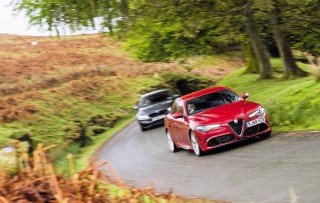
Much praised and now here in the UK, the Alfa is restoring faith in the Italian brand, coming almost out of nowhere to take on the sports-saloon establishment and claim the Nürburgring saloon-car lap record, too. Yet alongside the M3 it looks, dare I say it, a little tame. The Alfa’s 19in alloys are typically gorgeous but they look like 18s compared with the GTS-style 20in cross-spokes filling the BMW’s expensively, lovingly flared arches. It’s an altogether more subtle car, the Giulia, but undeniably handsome with it. Its strongest statement of intent is, of course, its twin-turbo 2.9-litre V6, whose 503bhp easily outpunches even the uplifted 444bhp of the Competition Pack’s 3-litre six.
It sounds like a recipe for ‘light the blue touchpaper and retire to a safe distance’ performance, in the manner of the original Maserati 3200GT, but while the Alfa’s performance is scintillating, it is also effortlessly well mannered and exploitable, even in its most aggressive drive mode. That comes as a bit of a surprise. So can the Alfa blend this refinement with inspiring on-road handling and involving on-limit track behaviour? To find out we’re going to let them loose on Wales’s heavenly, raggedy-arsed B-roads and also extract lap times at the Bedford Autodrome.
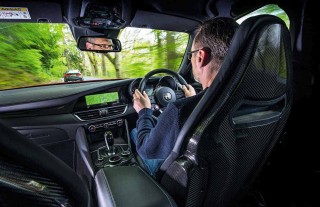
What instantly stands out is how different their steering feels. The M3’s is beefy, even in its lightest, Comfort setting, but it’s in character with the firm, heavily sculpted seats, bombastic start-up and taut ride. While you can individually adjust steering, damping and powertrain responses – there’s Sport or Sport+ as well as Comfort – even with everything backed-off the M3 is one steely character. It feels heavier than its size, more like an M5 than an M3, but after a few miles you’re dialled in to it and the ride comes good, too – it’s taut, yes, but comfortably rounded and gets better the faster you go. There’s plenty of grip, so the M3 feels solidly planted in corners but, as you’d hope for a punchy sports saloon, you get the sense that there isn’t so much stickiness at the rear that the twin-turbo engine won’t be able to overcome it…
Bury the throttle in the low gears and the sound is glorious; deep, metallic and menacing, especially from around 4000rpm when, apparently, the bungs come out of the tailpipes. The delivery escalates in line with the sound, which makes it unexpectedly naturally aspirated in feel, with a decent initial kick low-down, a swelling mid-range and a properly thrilling crescendo at the red line. A few tentative throttle squeezes suggest an easy breakaway in the dry – judging by the flickering stability control light – but given the heft of the steering and not knowing what the power delivery feels like when the tail is loose, I’m happy to wait until the track session to find out what happens.
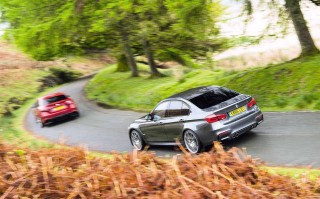
What a contrast the Alfa is. Its steering couldn’t be much more different – light, fast and so responsive that you have to calm your inputs considerably. Yet, as with the BMW, you soon adapt to it and, although it feels soft-riding, the nose darts when you turn the wheel. The Giulia’s cockpit features plenty of carbonfibre trim, but overall the ambience feels less expensive and less sporty, even though this car’s Sparco seats have the optional carbonfibre shells (£2950). They look a bit flat compared with the BMW’s but don’t be fooled because they feel superb and offer great support.
It’s a surprise, given that it churns out another 59bhp, that the Giulia’s biturbo engine isn’t spikier in its delivery than the BMW’s. The opposite, in fact; it’s stronger lower down and builds more gradually to the red line, the ZF eight-speed auto swapping gears with utter unobtrusiveness. To feel the full force of the engine and hear its unmuted voice, however, you’ve got to twist the mode dial round to its sportiest settings, at which point the stability control is disabled…
Heading to Wales on dark, wet, sometimes bumpy A-roads, I’m not up for that. Set to its most relaxed driving mode, the Alfa has an almost luxury-car demeanour, only the sharpest of bumps getting through, while on a light throttle the V6 settles to a rumble like the lowest note on a church organ – which is probably the cylinder deactivation kicking in. It’s a serene place to be and it’s hard to imagine it lapping the Ring in 7:32. The only dent in the relaxed feel comes from the brakes, optionally carbon-ceramic (as are the BMW’s), which are powerful but tricky to modulate. Are the standard brakes better, we wonder? Still, four hours to the Elan Valley is a breeze. This Alfa is a pussycat, yet to show its claws.
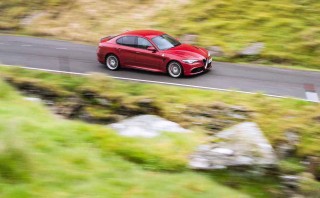
It’s exciting to see a couple of over-powered little sports saloons in the pale light of a grey, rainy morning in central Wales. Or maybe that’s just me: I see an opportunity to get into their limit handling at low speeds. Alfa first. Your options are unhelpfully restricted in the Giulia because there’s no separate stability-control button. If you want to turn it off there’s no choice but to twist the Ferrari-style ‘DNA’ rotary all the way round to Race. This also sharpens the engine and gearbox and firms up the dampers, though you can press the damper button and back them off to their mid setting (again like Ferrari). The bottom line is that you don’t have nearly as many setup options as in the M3.
In Race or ‘D’ you get to hear the V6’s lovely, rorty but refined yowl, which is not as loud or edgy as the BMW’s but encouraging. The Giulia feels a little firmer, a bit stiff-legged in its mid or firmest damper mode but still rides bumpy Welsh asphalt with impressive capacity and roundedness. The sharper throttle tests the traction more and, out of junctions on a light throttle, the inside wheel over-speeds harmlessly. The rear differential has electronically controlled clutch packs like Jaguar’s E-diff and so can deliver locking characteristics to suit the scenario. A provocative stab of the throttle gets both wheels spinning and there’s enough lowspeed torque that you can easily ride out low-speed slides on a small throttle opening. If you’re confident, the same applies at medium speeds, but as the roads dry out patchily and get faster, dropping back to ‘D’ to re-engage stability control feels prudent, as it does in the BMW. It’s now that you feel a bit cheated, not being able to have the best sound and biggest performance and stability control on.

Slightly surprising is that neither car’s steering offers much genuine feel. Also surprising, given that it seemed ready to slip in the dry, is the M3’s behaviour on these sodden, bumpy roads. Set damping and steering to Comfort to give the rear wheels the best grip and have the most manageable steering, set the drivetrain to Sport, and you’d expect to have a car as happy to swing as the Giulia. But no, the rear of the M3 takes some unsticking, and not because you have to rev the engine higher and harder; it just seems to have more mechanical grip. It will go, of course, if you goad it enough, and it’s impressive that although there’s a bit of a snap when it breaks away, you can balance it easily on the throttle. While the recovery isn’t the smoothest, it’s OK. And now, to Bedford!
ON TRACK
2017 Alfa Romeo Giulia Quadrifoglio vs. 2017 BMW M3 Competition Package F80
We have a little time before we can lap the West Circuit, so we bag ourselves a few over-the-limit shots, mindful of preserving the tyres for the business of setting lap times. In a reversal of their wet-weather behaviour, the Alfa doesn’t want to let go and fights to get hooked back up, which makes for some clumsy slide-catch-slides, while the M3 goes easily but, as its engine hits its peaks, slip isn’t consistent. So in both you need to be on top of your game for a tidy slide. Of course, for a fast lap you keep it neat and use the torque for forward motion…

So BMW first. When you’re not trying to provoke a drift, it’s more predictable and effective. With everything set to Sport+ and stability control off, you can feel when you’re about to run out of rear grip, and with the engine working hard that’s just about everywhere the car isn’t straight. Turn-in is positive and it’s an exciting lap, balanced on the limit so that small slides are being corrected even on the exit of the fastest corners, something you can do thanks to the confident poise of the M3. The carbon brakes are a little rumbly by the end but still pulling the car up strongly. The best lap is a 1:24.7.
And the Alfa? It doesn’t start well, the rear swinging with very little provocation at the first turn – an acute hairpin – but at the same corner on the first flying lap it’s found loads of grip and, as we found earlier, once it’s straight it hooks up strongly and will take full power. Body control doesn’t feel as stiff as the BMW’s but the Alfa is responsive thanks to the sharp steering and brakes. Oversteer is available early in the corners but from the apex there is a degree of understeer to push against, which feels useful in the quicker corners. On the third flying lap there’s suddenly no power to be had – the electronic diff has bailed and the stability control has kicked back in. Game over.
No matter, the Giulia has done the job, nailing a best lap of 1:23.6. The two cars share the spoils in terms of peak speeds before the braking areas but the Alfa carries more speed into the corners, hooks up sooner, and allows throttle-on in the faster stuff. Its gearshifts feel as swift and slick as those of the BMW’s DCT, too. Perhaps, though, the speed of the Alfa is betrayed by its tyres: the right front that does most of the work has suffered and the other three look a bit beaten-up, too. A check of their sidewalls reveals that while the M3’s Michelin Pilot Super Sports have a Treadwear rating of 300 (an ‘eco’ tyre would be 400), the Alfa’s P Zero Corsas have a rating of 60. Roughly speaking, the Michelins should last five times longer…
CONCLUSION
Considering they are aimed at the same customer, the Alfa and BMW are distinctly different propositions. On the spectrum from comfort to sportiness they overlap to a surprisingly small degree, the Alfa at its sportiest matching the BMW at its most comfortable. So what you expect from your potent, small sports saloon will probably decide which is the one for you.
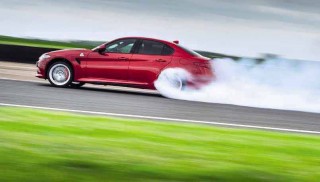
The M3 is now the car it should have been from the start. Compared with the Giulia, it’s a bit tougher at low speeds, a little less refined, but when it’s up to speed it’s superbly damped and the chassis balance is spot-on – the £3000 Competition Package is a must. It will feel too hefty for some, but it’s a thrilling car with a strong engine note and an exciting delivery that rewards revs. It looks the part, too.
The Alfa is the more nuanced car, more subtle in many ways, with a supple ride and a relaxed long-distance demeanour, yet it always steers with a directness that gives it a wonderfully agile feel. That engine delivers a big hit and works beautifully with the slick auto gearbox, though you have restricted access to its total performance and full-blooded soundtrack – some drivers simply won’t ever use Race because it turns off stability control. Even if you don’t, we wonder how long a set of those Pirellis will last. And yet, for all that, and the unsatisfactory brake feel, it’s hard not to be charmed by the Alfa.
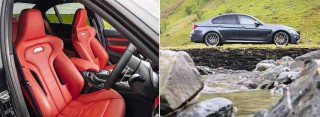
TECHNICAL DATA FILE 2017 Alfa Romeo Giulia Quadrifoglio
Engine V6, 2891cc, twin-turbo
Power 503bhp @ 6500rpm
Torque 443lb ft @ 2500-5500rpm
Transmission Eight-speed automatic, rear-wheel drive, limited-slip differential, torque vectoring
Weight 1620kg
Power-to-weight 315bhp/ton
0-62mph 3.9sec (claimed)
Top speed 191mph (claimed)
Basic price £61,300
Rating 5
TECHNICAL DATA FILE 2017 BMW M3 Competition Package F80
Engine In-line 6-cyl, 2979cc, twin-turbo
Power 444bhp @ 7000rpm
Torque 406lb ft @ 1850-5500rpm
Transmission Seven-speed dual-clutch (optional), rear-wheel drive, limited-slip differential
Weight 1560kg
Power-to-weight 289bhp/ton
0-62mph 4.0sec (claimed)
Top speed 155mph (limited)
Basic price £59,595
Rating 5
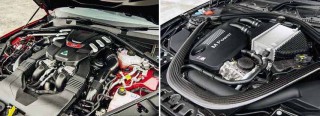
Left: both have twinturbo sixes, but the Alfa’s Ferrari-derived V6 is the mightier, delivering a searing 503bhp at 6500rpm. Even the Competition Package’s 444bhp at 7000rpm, up 19bhp on the standard M3, can’t live with that. Ultimate M3 does look superb though, both inside and out.
Above: the Giulia Quadrifoglio has impressed every time we’ve driven it, but how will it fare on tricky Welsh B-roads, and against the M3 at the very top of its game? Right: Alfa’s cabin can’t quite match the ambience of the BMW, but its carbon-shelled sports seats are terrific.
‘The growl of the M3’s straightsix evokes memories of the iconic M Power six of the E46’ This M3 isn’t going to be a pushover.
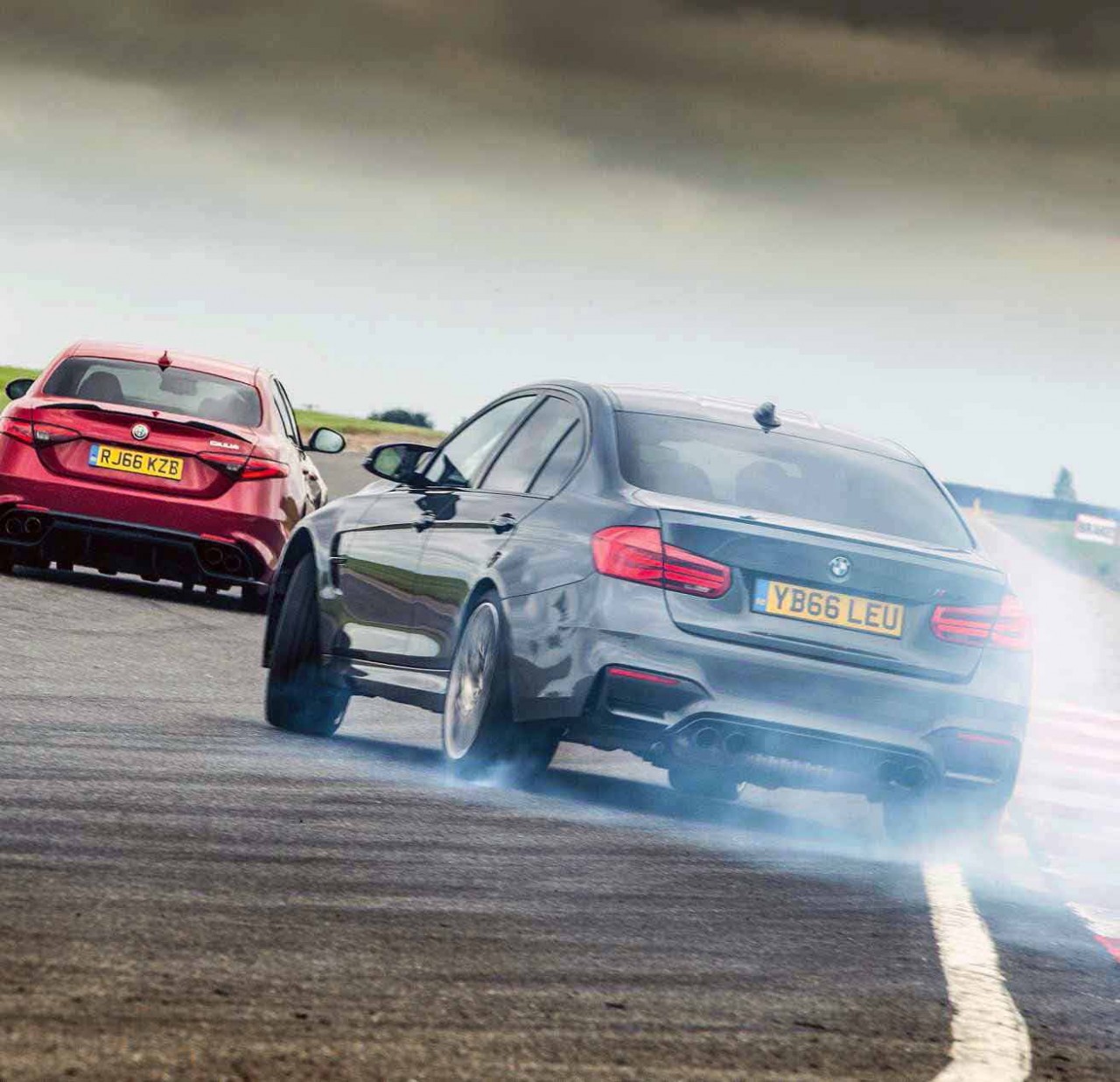
BATTLE OF THE SIXES Catch me if you can… BMW’s brutish M3 Competition Package chases down Alfa Romeo’s Giulia Quadrifoglio at Bedford Autodrome.
{CONTENTPOLL [“id”: 110]}





